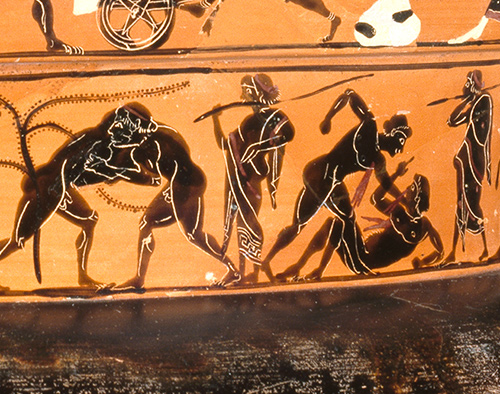I’m like Michael Corleone in The Godfather: Part III: “Just when I thought I was out. . .they pull me back in.”
When I wrote “Lysenko at the Olympics” on March 2nd, I assumed I would not be writing again about the movement to allow male-to-female (MtF) transgender athletes to compete against biological females until at least the 2021 Olympics (I predicted in that column that the 2020 Games would be canceled because of COVID-19), but the Supreme Court has pulled me back in.
On June 15th the Court ruled for the plaintiffs in Bostock v. Clayton County, GA (using here just the name of one of three cases decided together – see Hadley Arkes on the one specifically tied to transgenderism). Here’s the case summary from the Court’s opinion:
In each of these cases, an employer allegedly fired a long-time employee simply for being homosexual or transgender. Clayton County, Georgia, fired Gerald Bostock for conduct “unbecoming” a county employee shortly after he began participating in a gay recreational softball league. Altitude Express fired Donald Zarda days after he mentioned being gay. And R. G. & G. R. Harris Funeral Homes fired Aimee Stephens, who presented as a male when she was hired, after she informed her employer that she planned to “live and work full-time as a woman.”
A simple employment dispute, right? Wrong. The Court ruled that “homosexual” and “transgender” are actually sexes, not just sexual preferences, and since Title VII of the Civil Rights Act of 1964 bars discrimination based on sex, “gays” and transgender people may not be fired from their jobs if the reason for dismissal has to with their newly defined “sex,” now firmly put into law as equal to (i.e., the same as) heterosexuality. This is despite the fact that nobody really believes such equality was in the minds of those who wrote and approved the original law.
But Trump appointee Neil Gorsuch, who wrote the 6-3 majority opinion, plainly states: “homosexuality and transgender status are inextricably bound up with sex.”
As Trump appointee Brett Kavanaugh wrote in dissent:
The majority opinion insists that it is not rewriting or updating Title VII, but instead is just humbly reading the text of the statute as written. But that assertion is tough to accept.
Take that as you will. Amazing to think that Gorsuch was appointed by a Republican president to replace the great Antonin Scalia – or that Chief Justice John Roberts concurred in the decision.
Justice Gorsuch insists that in Bostock the “only question before us is whether an employer who fires someone simply for being homosexual or transgender has discharged or otherwise discriminated against that individual ‘because of such individual’s sex.’” But surely this is not true. Title VII is also about hiring, and – by extension – about participation.
To wit: I’ve got a crisp hundred-dollar bill right here to bet against anybody who asserts that every American sports federation isn’t soon to be sued by those demanding that MtF athletes be allowed to participate in women’s events without any sort of standards or restrictions having to do with testosterone levels or anything else. [Update: University of Pennsylvania Male swimmer, William Thomas, declared himself Lia Thomas, but on a woman’s swimsuit and won the 2022 NCAA championship in the 500-yeard freestyle event for women. Somebody owes me 500 bucks.]

So far, several factors, as I’ve alluded to in three previous TCT columns, have made the issue of MtF transgender people in women’s sports a significant but not world-changing reality – unless, that is, you happen to be one of the teenage girls against whom boys have been allowed to compete. The boys don’t always win, but they almost always do.
The factors so far mitigating the impact of men competing as women at the elite level include: MtF athletes are second-rate performers, otherwise they’d be competing as men; MtF athletes have usually been required to take hormone suppressing drugs, specifically to lower testosterone, the “male sex” hormone (if we can still call it that); and because of mandated time limits on declaring one’s intent to compete as a woman and having – for a year – a demonstrably lower T-level (one that, in biological women would still be very high).
None of this, of course, addresses the fundamental illogic of the assertion that an XY (male) individual can become XX (female).
I’m XY. I’m not proud of that fact, by the way. It’s laughable to be proud of biology. It’s borderline insane to assert that you can change your sex. Of course, this is why the term of art is now “gender,” which, formerly, meant “any of two or more subclasses within a grammatical class of a language.” (In French, for instance, all nouns are either masculine or feminine.)
Thanks to SCOTUS, “gender” is now legally, fully synonymous with “sex” in the biological sense.
But that does not make it a fact in biology. Gender, in the cases decided by the Court, is an assertion of preference (absolutely so in the case of transgenderism), and one that until recently – in its manifestation of a person of one sex claiming or wishing to be the other sex – was known as gender dysphoria. In 2017, that disorder was banished from the Diagnostic and Statistical Manual of Mental Disorders, Fifth Edition (DSM-5), the bible, you should pardon the expression, of the American Psychiatric Association. The APA had earlier (2012) opted for gender dysphoria over “gender identity disorder.” And, until 1973, the APA had listed homosexuality as a treatable disorder.
Like the Supreme Court in Bostock, DSM-5 has nothing to say about sports and who shall compete, and when the lawsuits come and restraining orders are issued – sending cases up through the appeals process (perhaps landing again in the laps of the SCOTUS judges) – only then will we know if the hard-won right of women to fully compete against other women will, at the elite level, be compromised by the inclusion of opportunistic men, who’ll say, now with the force of law, “You cannot exclude me. The Court has affirmed I’m a woman!”
And, speaking of bibles, in THE Bible we read, “in the image of God he created them; male and female he created them.” Obviously, some think this needs updating.
__________
*Image: Attic black-figure volute krater (detail) attributed to the Leagros Group, 510–500 B.C. [J. Paul Getty Museum, Los Angeles]. Officials are seen overseeing an athletic competition. They rest switches on their shoulders to use for beating cheaters.















